OP-ED: BABOONS AND HUMANS
More problems than solutions: Being paid to kill Western Cape baboons is no way to manage wildlife
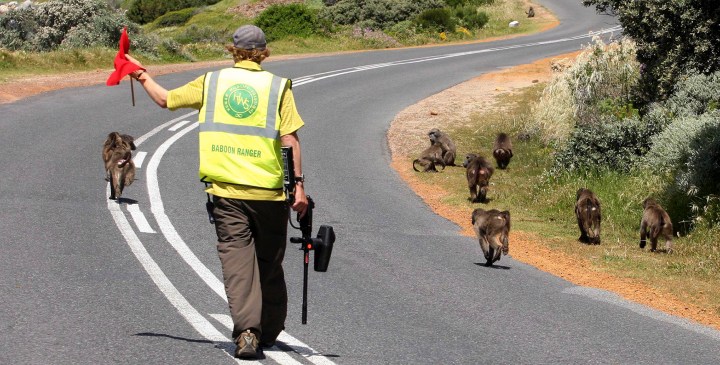
Pete Oxford has responded to an opinion piece by Phil Richardson, owner of Human Wildlife Solutions, a company that holds the contract to manage baboons in the Overberg. Oxford asks why HWS has long criticised an ‘anthropomorphic’ consideration to managing baboons, despite a global swing towards a more empathetic approach to wildlife management as we slowly emerge from the dark ages. To Human Wildlife Solutions, a baboon is a baboon — they give it a number, almost like a commodity, he says.
Pete Oxford is a qualified zoologist, professional naturalist, photographer, writer and conservationist. He has spent more than three decades in intimate association with wildlife in some of the wildest places on earth. He has travelled repeatedly to all continents, including 15 times to Antarctica. He has published 14 books. He lives in the Overberg.
I am writing in reference to the article published by Phil Richardson on 3 October 2021 in Our Burning Planet.
The article wants to come across as a voice of reason, as I am sure it will to a large number of Daily Maverick readers not fully au fait with the realities on the ground. It is, however, loaded with sinister overtones and blame which need to be laid to rest.
I know Richardson personally and find the article consistent with his one-sided public arguments regarding baboons.
He talks at length in the article about his experiences with lions, elephants and baboons. I’m not really sure why. We all have bedtime animal stories. He references that, like me, he has worked with National Geographic. We are both credible.
I looked up the films they have made which he referenced. I found them impossible to find anywhere on the internet. I did, however, manage to dig up a 13-minute clip.
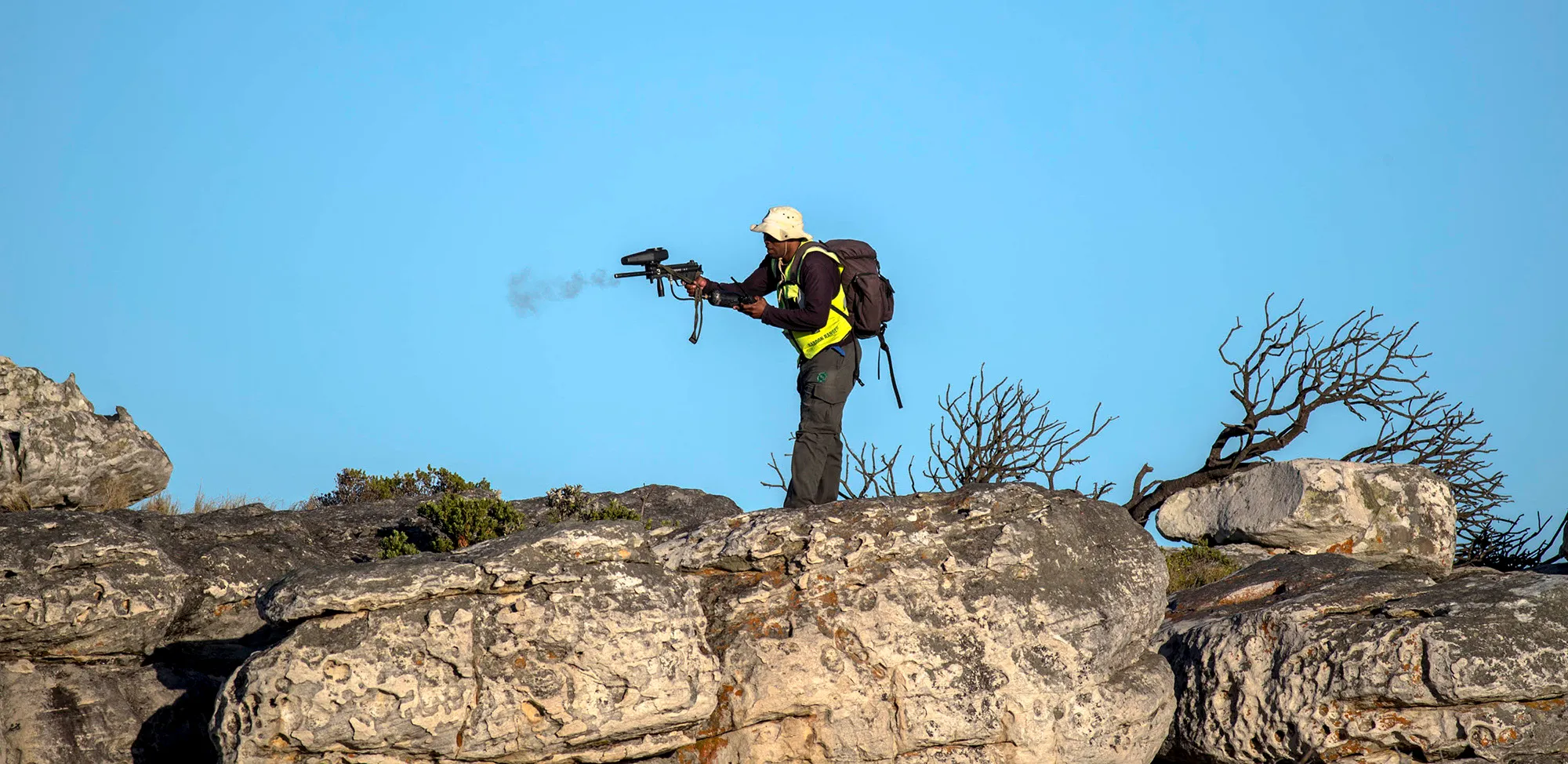
A Human Wildlife Services ranger fires his paintball gun at members of the Slangkop baboon troop to keep them contained on Slangkop Mountain above Kommetjie in the deep south of Cape Town. (Photo: Alan van Gysen)
HWS has long criticised an “anthropomorphic” consideration to managing baboons, despite a global swing towards a more empathetic approach to wildlife management as we slowly emerge from the dark ages. To Human Wildlife Solutions (HWS), a baboon is a baboon — they give it a number, almost like a commodity.
Imagine my surprise when I watched the clip. It was mostly about a lion pride, filmed in the late 1990s. It was the epitome of habituation. The lions had been given names and individual characters were recognised. “Shumba the lioness was so confident and full of life… Kavinga was a wonderful lion, with a superb confidence about him. Mrs Hunter was a fantastic and very gentle mother… Farai was without a care in the world, an indomitable little fellow.”
What’s best, said Lynne Richardson, Phil’s wife and co-owner of HWS, talking about a lion, “is that he is relaxed with us and accepts us. Speaking to them very gently and quietly makes them relax”.
Writing about the baboons in his camp, Richardson states that they were “always wary of us”. Yet, the clip shows him walking towards a stationary baboon standing outside his tent a few feet away, and other baboons bouncing all over the tent roof!
What happened, Mr and Mrs Richardson? Where did you lose your empathy? When money was involved?
The article goes on to reference a rather poisonous letter written by Shirley Strum, against “activists”. It was written a decade ago, with reference only to those baboons in and around Cape Town. It was not, or is, at all relevant to the Overstrand (where Richardson is working as the owner of HWS after not having had their contract renewed in Cape Town) — nor is there any reference to Strum’s subsequent letter of 2018 where she essentially changes her tune and blames poor waste management as being a root cause of baboon/human interaction.
Strum is certainly not the only primatologist in the “circus”.

Primatologist Dr Jane Goodall. (Photo: EPA-EFE / David Mariuz)
Then to go on and disparage Dr Jane Goodall about her work and methods from the 1970s is rather below the belt! Has he picked on her specifically because she has now written two letters to me personally regarding the Betty’s Bay troop, where nothing that she mentions has not come true under the flawed management style of HWS?
He goes on and on against her, blaming deliberate feeding as a problem. Here we agree — feeding baboons is a problem. Tell it how it is, though. “Deliberate” feeding by allowing baboons access to bird seed and public and household waste and so on needs to be addressed urgently. It is well known that the quickest and most effective way to habituate any animal is through food rewards.
Richardson uses a lot of space in the article to “blame” habituation, with particular mention of photographers being responsible. Having been accused repeatedly, both in public and in private, by Richardson as having habituated our baboons (in order to fulfil a desire to photograph them and make lots of money, he claims), I take this as a veiled accusation against me and will answer as such.
First, I take images of them, yes, for local education purposes, but I have never sold a single Betty’s Bay baboon image. Nor have I distributed them to any of my agents. Please lose this disparaging statement. Richardson seems incapable of accepting that an animal habituated to humans is habituated to humans, not just specific individuals. Dozens of times, for example, we have watched fully uniformed HWS monitors, in bright yellow vests, sitting very close to our baboons, with no reaction from them.
If they start to shoot at them or chase them, then the baboons scatter.
This, Mr Richardson, is where the problem with your management starts. When HWS was awarded the contract to manage baboons in Betty’s Bay, there are a few things to remember. Firstly, Richardson was fully aware that the troop was totally habituated before he was given the contract, even commenting while we were together with them “how wonderfully chilled” they were. Now he claims it as the reason for their failure to solve the problem. They have only, so far, succeeded in displacing the issue.
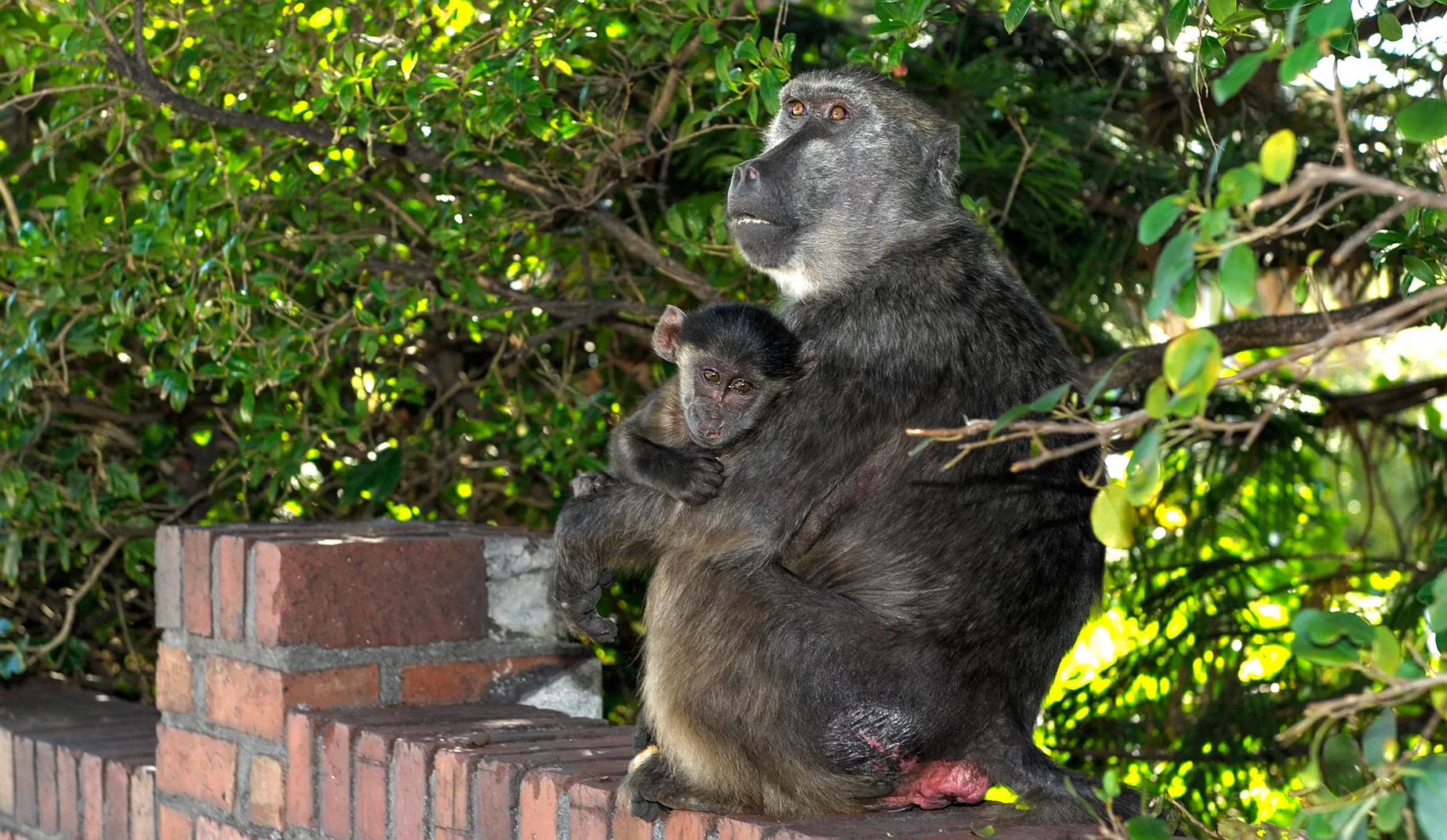
Mother and baby from the Waterfall baboon troop, Simon’s Town.
(Photo: Joyrene Kramer)
Second, the contract was awarded, via a deviation process, based on the municipality being sold the idea of the efficacy of the “virtual fence” which was hailed as the answer. It has been deployed repeatedly in and around Betty’s Bay now, but has not worked. Should we ask for our taxpayer’s money back and start again? It is a lot of money, to be sure.
The Betty’s Bay troop is fully habituated, but no more so, according to renowned primatologist Dr Dave Gaynor, than almost every other troop on the peninsula. The individual troop members have each spent their entire lives in association with the urban area of Betty’s Bay. They have been getting into houses, opportunistically, or by removing sliding doors for many, many years — long before I arrived on the scene. There are many long-time residents who will corroborate this, even with photographic evidence. We can therefore ignore those that say they never saw them.
He talks of a natural fear of humans by animals and birds. They only usually fear us when they have been previously hunted. No hunting, no need to fear. It is “the natural order of things”. How many examples do you need? In fact, with specific regard to baboons, we once hiked to a remote troop in the Waterberg, which had seldom, if ever, had previous contact with humans. They all came towards us to check us out!
Then there is the fear-mongering of baboons being dangerous. Sure, they have big teeth and they could do damage if they wanted to. In the neighbouring village of Rooi Els — living a coexistence model with baboons where they are very regularly in the village — there has not been a human bitten by a baboon in 50 years.
We are not told the full story regarding the freak event of a poor child’s injury that was referenced. There is a backstory to the incident. Interestingly, some of the same people who claim baboons are dangerous, keep very dangerous dogs inside their homes. My father-in-law, a doctor once, literally had to sew a girl’s face back on after being attacked by her neighbour’s pet. He has sewn up many other dog injuries. Indeed, South Africa has the highest incidence of fatal dog attacks, per capita, in the world. Yet we accept living in intimate association with them.
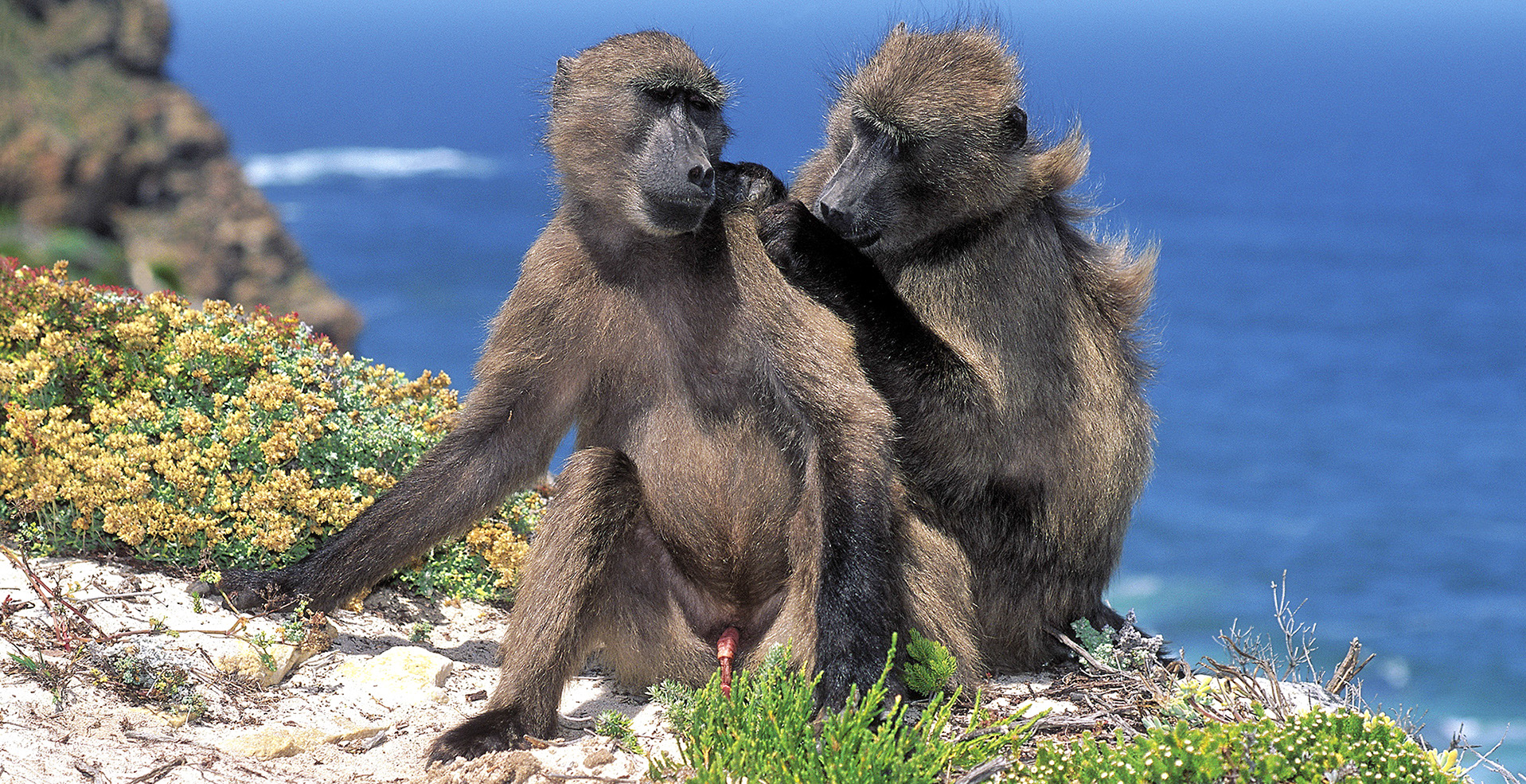
A baboon grooms a fellow troop member at the Cape Point Nature Reserve in Cape Town. (Photo: Gallo Images / Mark Skinner)
HWS promotes baboons as being dangerous — they actively fear-monger about them in the community. It keeps their cause alive and justifies their need. It would be a shame for them, no doubt, for the public to understand that the about R26-million for three years to manage 166 baboons might be construed as “fruitless and wasteful expenditure”.
What a pleasure it would be if HWS actively worked themselves out of a job through education and understanding. Helping apply pressure for waste management protocols, introducing easy fixes to stop return visits by baboons to houses, possessing an (unbiased) understanding of baboon behaviour and showing empathy towards solving the conflicts, rather than needing them to remain employed. I could live with that.
Perhaps wildlife should not be “managed” for profit in the first place!
My concerns are widely shared, as evidenced by the hundreds of people who felt the need to publicly protest against HWS while they were still operating in Cape Town. Now, after HWS has forged their way east to the Overstrand, hundreds are marching against them once more.
This, after already killing one of our troop’s three adult males, Scarface. It was telling that one banner read, “Solutions not Executions!”
Lynne Richardson told the media how saddened she was by the “need” to kill Scarface, yet she actively canvassed against him. Nothing was done to resolve his behaviour, but simply criminalise it, playing always to her sycophantic, radical following.
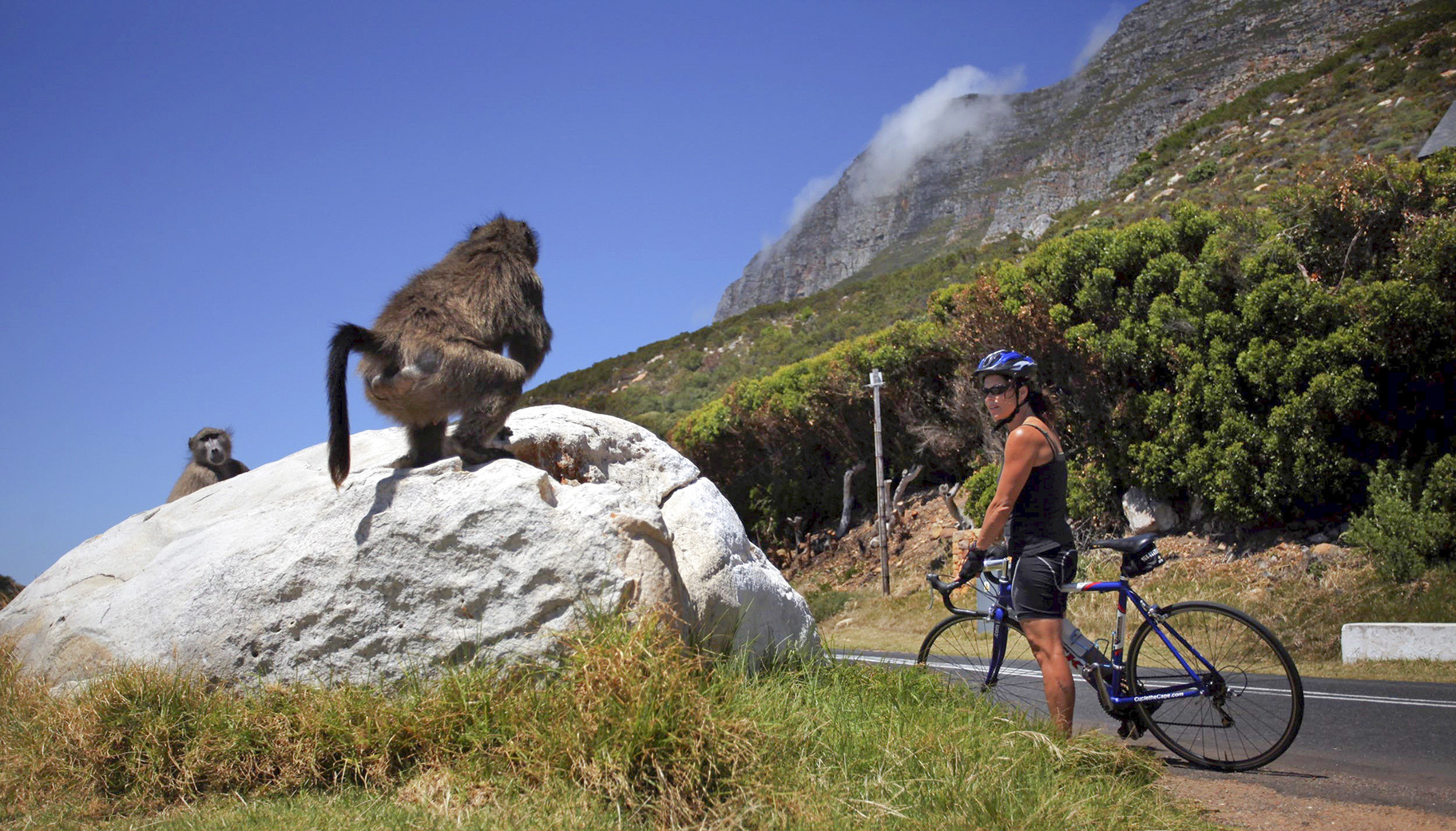
A cyclist watches baboons close to Cape Point, Cape Town. (Photo: Gallo Images / Sunday Times / Marianne Schwankhart)
HWS have called for us in Betty’s Bay to be patient. The Cape Peninsula, however, waited 10 years — scores of baboons were killed and nothing changed. Baboons are still coming into the urban area.
How patient do you want us to be, HWS?
It was Einstein who famously said, “Insanity is doing the same thing over and over and expecting different results.” If we expect things to change by allowing HWS to repeat the same things over and over, then surely it is we who are insane.
We cannot avoid the fact that if there is tension in our biosphere, then there is a problem.
Baboon management systems need to change and adapt to individually unique situations. We have made proposals, as yet to no avail, but, in the words of Richardson, “that is another story”. DM



















 Become an Insider
Become an Insider
Thank you for your piece on that propaganda against baboons. Truly, our baboon problems begin with humans who seem not to get the simplicity of things.
All it will take for humans to live peacefully with wildlife and baboons is for us to outwit them, but I observe how astonishingly problematic this is.
Baboons are wild animals. Baboons are not domesticated animals. In general human society is organised so as to separate human habitation from the habitation of wild animals. I have not held a referendum to determine whether the general opinion of people is that they prefer this separation or not but I suspect we all know that any referendum would reveal that the vast majority would prefer for the separation to be maintained and improved. It is impossible to ask the baboons so lets not fantasise on their opinion. I suggest with conviction therefore that anyone who wants to subject any human community to living side by side with baboons, or any other wild animals, is bound to fail and needs to spend time more constructively on how to make life better for the human species – some of whom pay taxes.
100%
Wow! Now that is an astounding sense of entitlement.
As a landowner with years of trial and error I have learned a couple of things (this is all anecdotal)
1) They were here first, not us!
2) They are highly intelligent and adaptive – chasing them around with paintball guns, crackers, air-cannons, drones, slingshots or rifles is an ignorant primitive knee-jerk temporary solution! They learn quickly whom you are, what car you drive and spot you a mile away so forget it.
2) Access to easy calories artificially boosts their fecundity with unappreciated knock-on environmental effects. I have witnessed scorpions, insects, rare plants and even bee-hives decimated in desperation as troop sizes increase beyond the natural carrying capacity of a home range that a troop is unable to expand out of.
3) A wounded/cornered or aggrieved adult male is extremely dangerous! – many dogs shredded to ribbons and there is good reason why our leopards do not prey on them. Check the blades behind a male baboons canines!
4) The solution I found that works best is to set remote (no human interaction!) noxious booby-traps triggered specifically by inquisitive naughty youngsters. These consist of 12g shot-shells filled with chili powder that are detonated by pulling a pin baited with an irresistible curiosity such as a shiny childs toy. The juniors cannot resist setting these things off and being responsible parents, the adults have very quickly learned to keep their naughty kids well away.
The scorpions and I are much happier now.
An excellent yet unemotional analysis on this topic can be found on DM under the title “Cape Town’s baboon programme: Successful coexistence between wildlife and urban communities through trial and error”
A while ago, when I was trail running towards the mast on Constantiaberg.
As I came round a bend, I came across a baboon family sunning themselves. I decided to continue running without looking at them or changing my pace.
They ignored me and I ignored them, until out of the corner of my eye I noticed that a baby baboon had become interested in me and was coming towards me. Immediately the mother baboon stretched out her long arm, pulled the baby baboon towards her and then gave it a thump on bum before settling him next to her.
It was a wonderful experience which I remember to this day +- 30 years ago.
Wonderful riposte, wise words, thank you Pete!
Baboons are very intelligent and those that have retrieved a copy of the DM from a raid on PnP are amused at both articles. First the personal jibes must be leaving a canine smirk on their faces as they witness the hapless humans slinging barbs at each other. Second they are nodding their heads at the failure or only partial success of all the management techniques. They are planning their next work around. They know that there is no solution except genocide, which I and most suburbanites find unpalatable. What’s left is an an uneasy coexistence. The area where I now live is suburban and coexists with deer, who strip vegetable gardens in a flash, coyotes who dispose of small dogs and cats (song birds give thanks) and on occasion the odd mountain lion and bear. The baboons in CT, vervet monkeys in Kloof, puffadders in Franschhoek and jackals in the Karoo towns are here to stay, we have to adapt. Let me clarify my point about genocide…I wasn’t referring to the baboons.
One of my saddest moments at Cape Nature in the early 90s was helping with capture of a “rouge” male. Those intelligent eyes bored into us as he was shot.. The ranger who pulled the trigger swore they would never do it again. They were traumatised. We were traumatised. Personal mud slinging aside I agree with Peter Oxford.
Everyone I know who has to contend with these animals on a daily basis will support any measure to deal with the problem.
The problem is the need of humans to encroach on their territory without appreciating that if we want to continue chasing baboons from their naturally habitats, we are de-humanising ourselves. I grew up in Simon’s Town, and baboons (and Penguins) where part of out daily lives. There was no need to shoot them or chase them away, we just existed together. However as people moved into the town and started building up on the mountain, the need to chase baboons away (and fence out penguins), grew exponentially. If wildlife is going to be an issue for you, don’t move into an area where they are prevalent. It is like moving to Cape Town and complaining about the South Easter
Hear Hear!
I have to contend with baboons on an ongoing basis. On one side a very large mountain nature conservancy where they may roam freely; on the other side my presently immature tree nut orchard. The only thing that has worked effectively thus far, is an electric fence
In this current situation of the people vs baboons, the baboons are always going to be the losers. Sadly.
With HWS having their finger on the trigger, they will always find a way to justify their actions, as will the Overstrand Municipality in their compliance with “awarding” them the contract. I live in Voelklip, Hermanus and that virtual fence???? It doesn’t work. Me thinks maybe we should award the baboons the contract to start managing their human problem. Imagine? Another problem is the lack of environmental knowledge, caring and awareness with OM staff. And lastly, all these municipal workers need to remember who pays their salaries, yes the residents of the town. What will be left for future generations to marvel at in nature and the wild? I wonder if anyone had a discussion about over hunting of the Dodo before it became extinct? As modern day custodians, those tasked with the job have done a poor job.
What happened to all those nice cuddly lions that were here?
Stopped reading during all the ego passages.
I tried, maybe next time.